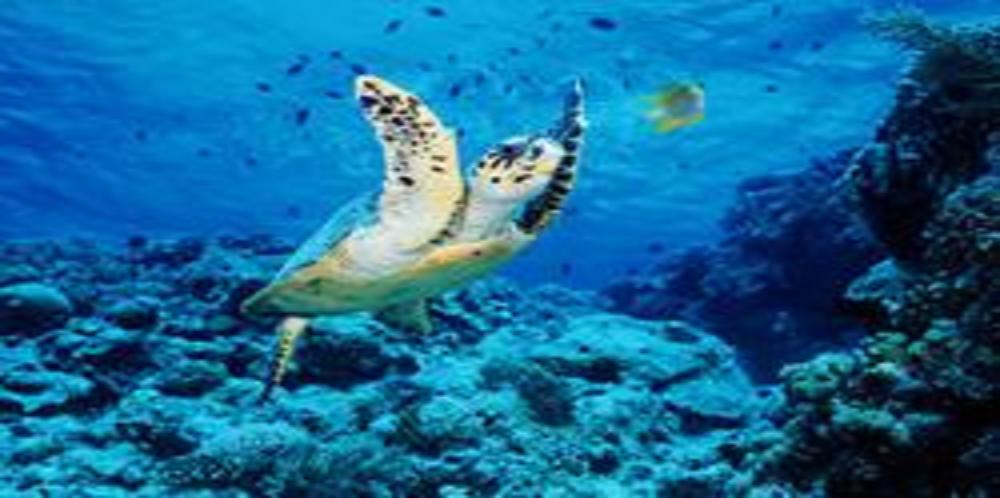More than 20 prominent investigators from the Mexico, Guatemala, El Salvador, Nicaragua, Costa Rica, Colombia, Ecuador and the United States, experts on the biology, conservation and management of marine turtles, came together between the 15 and 17 of July to share information on hawksbill turtles (Eretmochelys imbricata) in the Eastern Pacific Ocean.The meeting, called the “First Workshop of the Hawksbill Turtle in the Eastern Pacific”, was held in the Los Cóbanos Natural Protected Area in El Salvador, Central America.
According to the Red List of Endangered Species of the International Union for the Conservation of Nature IUCN, the hawksbill turtle is considered Critically Endangered.Its status in the Eastern Pacific is particularly worrisome as the information available until recently indicated the species as being essentially extinct.Evidence from various sources indicated that populations of hawksbill turtles in the Eastern Pacific have been reduced to just a vestige of what they were in the past, with the reduction having taken place prior to the start of the modern conservation movement.
During the meeting, experts pointed out the continued existence of various threats to hawksbills including their capture and death during fishing activities, the harvesting of eggs, coastal development and the hunting of individuals for their shell, which is used to create handicrafts.
Nonetheless, during meeting it was also shown that there is still hope for the species in the Eastern Pacific.The experts shared information from their perspective areas and for the first time ever, generated a regional map displaying documentation of the species, including nesting reports, in-water observations and strandings.They also issued a resolution indicating the continued risks to hawksbill turtles in the Eastern Pacific and the actions recommended be taken by local governments to guarantee the conservation of the species.To continue sharing information on hawksbills and strengthen regional policy for their conservation, a working group was formed called the “Eastern Pacific Hawksbill Initiative”.
“Just ten years ago there wasn’t enough information available to hold this meeting and we thought it might have been too late for hawksbill turtles in the Eastern Pacific” said Dr. Jeffrey Seminoff of the SouthwestFisheriesScienceCenter of the National Oceanographic and Atmospheric Administration NOAA (USA).“This meeting is truly historical and has shown us that now more than ever we must work together for the conservation of the species” added Seminoff.
The decision to convene the meeting in El Salvador stems from the recent finding that the country hosts the greatest abundance of hawksbill nesting in all of the Eastern Pacific, particularly in Bahia de Jiquilisco, in the eastern part of the country.“It was believed that there were no sites in the Eastern Pacific where hawksbill nesting occurred more than sporadically”, stated Mauricio Vázquez, of the Instituto de Ciencias del Mar y Limnología de El Salvador ICMARES.“The new findings in El Salvador are encouraging.We registered more than 160 nests in 2007, that’s more than 65% of all the nesting reported for hawksbills in the entire region.Now it is the responsibility of all Salvadorians to guarantee that the species does not succumb to the anthropogenic pressures that have brought it to its current critical state” affirmed Vasquez with hope.
“The hawksbill turtle is highly migratory and requires regional efforts to ensure its survival” asserted Alexander Gaos of Pro Peninsula (USA) and who was elected as the regional representative for the Hawksbill Initiative during the meeting.“That is why we recently visited Bahia de Jiquilisco, and with the help of coastal community members, equipped satellite transmitter to three nesting hawksbills in an effort to study their migratory movements and with the information generated, define better conservation and management strategies” added Gaos.
“We must take urgent actions to recover this species, especially considering the new information discovered during the meeting, such as the strict protection of hawksbill nesting habitat, the banning of consumption of their eggs and the implementation of effective technology to avoid their capture during fishing activities” declared Randall Arauz of Programa Restauración de Tortugas Marinas PRETOMA (Costa Rica).
The meeting was financed by NOAA, the United States Agency for International Development USAID in El Salvador, and the organization Ocean Conservancy, and was supported by the Fundación Zoológica de El Salvador FUNZEL and ICMARES. Additional organizations represented at the meeting include Conservation International, California Academy of Sciences, Universidad Nacional Autónoma de Mexico, Grupo Tortuguero, Asociacion de Rescate y Conservación de Vida Silvestre ARCAS, Ministerio de Ambiente y Recursos Naturales MARN de El Salvador, Flora & Fauna International, WIDECAST –Latin America, Centro de Investigación para el Manejo Ambiental y el Desarrollo CIMAD, Charles Darwin Foundation and Equilibrio Azul.
For photos of the workshop and recent hawksbill turtle work conducted in El Salvadorvisit:http://drop.io/ephawksbill




